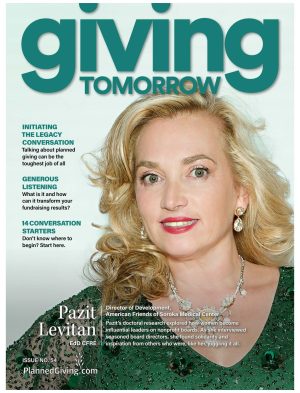“Response rates from newsletters are down! Attendance at my annual seminar is way off…” fundraisers tell us.
What did you think was going to happen?
Those old methods are simply not working anymore. While you weren’t watching, the prospect pool has changed. They’re more knowledgeable, more independent—and— skeptical, harder to reach and to persuade.
And yet, too many fundraisers still have the mindset of 1968, when the world was changing and planned giving was news. The world is different today. Your prospects are awash in planned giving material—from you, from their college, from their kid’s college, from their grandkid’s school, from the National Association to Save the National Associations. So your safe, four-times-a-year, place-your-name-here newsletters aren’t working anymore. In addition, your newsletters are drowned out by mailers from the supermarket next door, Chevy dealer, and thousands of coupons from Val-Pak. And… from the non-profit next door.
So what’s a fundraiser or planned giving officer to do? Here are seven action-steps:
1. Stop telling your prospect you’re waiting for him to die.
What’s the third sentence of every promotion you mail out? “When you or your beneficiary dies, the remainder will come to us here at Happydale.”
Okay, most elders have come to accept that death is creeping up. But why should you be the face of the grim reaper?
If you’re promoting features of a planned gift, then you’re telling your prospects how it works (not what it does for them and for you) — this means what they’ll hear is that the sooner they kick off, the sooner you’ll get their money. You might as well be selling cemetery plots.
Focus on benefits and results. The benefits and results of a planned gift are immortality: your vision, and your name, can live on forever… That’s what your marketing must convey. Leave the re-hash of tax-law update you picked up at the last planned giving seminar for e-mail flame wars with your cross town buddy Chett, who was sure that his lead trust was bigger than yours.
2. Use the right tools. You can’t cut wood with a hammer.
Your prospects are inundated with over 3000 marketing messages a day — so they’re not sitting on the edge of their seats waiting to read your newsletter on how to part with their wealth after their death. An assembly line product from your newsletter vendor just won’t make it to the top of their to-read pile any more.
What to do? Provide alternatives such as retirement planning advice or how they can protect their documents while abroad. Improve your newsletter’s appeal with stories of donors (get permission!) with whom prospects can identify. Send out our document titled 8 Pitfalls in Writing Your Will, for example, and supplement it with giving information. If you decide to publish a planned giving newsletter, it should never be outsourced. Take the time to craft one very carefully yourself.
Since traditional planned giving newsletters don’t get read (today’s prospects are active; they might get to your newsletter between working on their ‘72 Chevelle or chasing after grandkids at the zoo), use creative postcards. You’ll gain precious seconds while they scan your message — instead of tossing an unopened envelope from “The Office of Development” into the trash. (You could put shred immediately on the envelope and get better readership.)
3. Stop following hype.
“I can contact 8000 prospects with my Send key. And it’s cheap!”
Actually it’s not. Consider costs incurred after the e-mail blast. At first the response may be fine. By the third contact most emails will be deleted. And many recipients will be annoyed by that unwelcome blast. Remember, most Americans (73%) still prefer their information via US mail. When they’re being asked to consider a gift, I bet even more feel that way.
What’s worse? Automated planned giving marketing services that send out the same email blasts for all their clients. It’s possible that prospects and advisors can receive the same piece from 12 different non-profits. If you go down this path, you deserve what you get (nothing).
Solution? Instead of an email blast, piggy back on other e-marketing initiatives at your organization, and talk about how creative gifts (i.e., planned gifts) can help achieve your mission and their vision for a better world.
4. See what you say and what you do through your prospect’s eyes.
The next time you decide to stir up your prospects by offering “exciting” planned giving articles on your website (I get chills just thinking about what your prospect did with his life insurance), sit down and reflect:
Your website is not Entertainment Weekly, and prospects will not re-visit it daily to learn the latest scoop on unitrusts. (Okay, if they do, either they’re a retired planned giving officer or you really need to offer more volunteer opportunities.) We hate to admit it, but to the average civilian, planned giving is boring…
Your prospects want personal, relevant information they can use. They also want to know how their gift will help you (yes, you). Your institution possesses a unique advantage and you have a special relationship with your prospects because of your mission and the fine way you carry it out. Harness the power of this relationship with mission-driven marketing.
5. Focus on marketing, not fundraising.
No, this wasn’t covered in the How to Impress Your Boss with Esoteric Trusts seminar you took. Planned giving is more the art of donor-centric marketing than the science of fundraising. Your resources should be focused on marketing and yes, “sales” (the dreaded word) and less on teaching how gift plans work. What are you selling? The mission and vision of your organization and the excitement and hope it provides. That’s huge. Help your prospects be part of that. Always focus on getting yourself in the prospect’s door. After all, what good is it if you know how to skip a generation, replace assets with life insurance and flip their trust if you can’t get them to sit down with you for coffee?
6. Stop chasing the wrong people.
Do you know where (and who) your prospects are? If you’re still mailing to everyone, to just old folks, or all the wealthy ones, you don’t. Your prospects are the ones who have consistently supported you year after year — your loyals. Go for loyalty and communicate with that group often. They want to see their legacy live on. They are your acres of diamonds.
By narrowing your list and mailing to them often, you’ll get better results than mailing less often to a larger group… even if, because of chance, you miss a few prospects by not mailing to the larger group. There are proprietary tools out there (such as PGFinder) that identify your best prospects based on donor loyalty. The likelihood of a planned gift from a prospect identified through these tools is far, far greater than through traditional means. So, unless you have an unlimited budget for postage, select a highly-targeted group, and mail to that group early and often. Better yet, select an even more highly targeted group and wear out your shoe leather.
7. Stop binge marketing.
“Oops… business is slow, I better send out a mailing.” Sound familiar? It’s the classic cry of a binge marketer. If you find yourself in the middle of a quiet spell thinking a few actions here and there between visits to your boss’ office to increase your budget for your newsletter will get things moving again, it won’t.
Successful programs maintain consistent marketing. A little bit of this, a little bit of that is reactive and unproductive. Result? You’ll miss out on long-term benefits of a smooth, strategic and stable giving program.
Let’s be clear about this: marketing is not rocket science. But it takes time to work. Frenetic, desperate actions intended for short term results come across that way, making you look like an organization in panic. That is not the way to build trust and confidence—it’s exactly opposite of the message that gets gifts. And this lack of composure easily reveals itself to prospects in more ways than one. Most are weary of donating to organizations in perpetual crisis, and your appeal will be tuned out while they turn up their iPod.
If you say, “I don’t have time,” that’s the first sign that you’re running a reactive campaign. Immediate solution? Outsource. Your return on investment will be worth it—not just for your organization, but for your peace of mind as well.
Read what works and what doesn’t in planned giving marketing.
Category: Planned Giving Marketing






